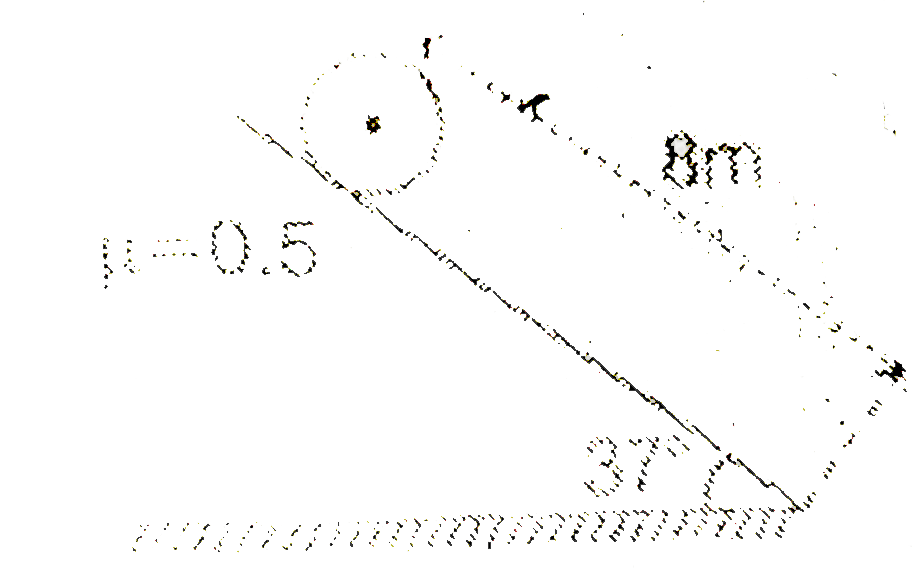A body is moving is down an inclined plane of slope 37∘ the coefficient of friction between the body and the plane varies as μ=0.3x, where x is the distance traveled down the plane by the body. The body will have maximum speed. (sin37∘=35) . a) at x = 1.16 m b) at x = 2m c) at bottom most point of the plane d) at x = 2.5 m
at x=1.16m
at x=2m
at bottommost point of the plane
at x=2.5m
The correct Answer is:D
To solve the problem, we will follow these steps:
Step 1: Analyze the forces acting on the body
The body is moving down an inclined plane with an angle of 37∘. The forces acting on the body include:
- The gravitational force mg acting downwards.
- The component of gravitational force acting down the incline: mgsinθ.
- The normal force N acting perpendicular to the incline: N=mgcosθ.
- The frictional force Fk acting up the incline, which is given by Fk=μN.
Step 2: Write the expression for the net force
The net force acting on the body can be expressed as:
Fnet=mgsinθ−Fk
Substituting the expression for frictional force:
Fnet=mgsinθ−μmgcosθ
Given that μ=0.3x, we can rewrite the equation as:
Fnet=mgsinθ−0.3x⋅mgcosθ
Step 3: Set the net force to zero for maximum speed
At maximum speed, the net force will be zero:
0=mgsinθ−0.3x⋅mgcosθ
This simplifies to:
mgsinθ=0.3x⋅mgcosθ
Dividing both sides by mg (assuming mg≠0):
sinθ=0.3xcosθ
Step 4: Solve for x
Rearranging the equation gives:
x=sinθ0.3cosθ
Using the identity tanθ=sinθcosθ:
x=tanθ0.3
Step 5: Calculate tanθ
Given that sin37∘=35, we can calculate cos37∘:
cos37∘=√1−sin237∘=√1−(35)2=√1−925=√1625=45
Now, we can find tan37∘:
tan37∘=sin37∘cos37∘=3545=34
Step 6: Substitute tanθ into the equation for x
Substituting tan37∘ into the equation for x:
x=340.3=34⋅0.3=31.2=2.5 m
Conclusion
The body will have maximum speed at a distance of x=2.5 m.
Final Answer
The correct option is d) at x = 2.5 m.
---
The body is moving down an inclined plane with an angle of 37∘. The forces acting on the body include:
- The gravitational force mg acting downwards.
- The component of gravitational force acting down the incline: mgsinθ.
- The normal force N acting perpendicular to the incline: N=mgcosθ.
- The frictional force Fk acting up the incline, which is given by Fk=μN.
The net force acting on the body can be expressed as:
Fnet=mgsinθ−Fk
Substituting the expression for frictional force:
Fnet=mgsinθ−μmgcosθ
Given that μ=0.3x, we can rewrite the equation as:
Fnet=mgsinθ−0.3x⋅mgcosθ
At maximum speed, the net force will be zero:
0=mgsinθ−0.3x⋅mgcosθ
This simplifies to:
mgsinθ=0.3x⋅mgcosθ
Dividing both sides by mg (assuming mg≠0):
sinθ=0.3xcosθ
Rearranging the equation gives:
x=sinθ0.3cosθ
Using the identity tanθ=sinθcosθ:
x=tanθ0.3
Given that sin37∘=35, we can calculate cos37∘:
cos37∘=√1−sin237∘=√1−(35)2=√1−925=√1625=45
Now, we can find tan37∘:
tan37∘=sin37∘cos37∘=3545=34
Substituting tan37∘ into the equation for x:
x=340.3=34⋅0.3=31.2=2.5 m
The body will have maximum speed at a distance of x=2.5 m.
The correct option is d) at x = 2.5 m.
Topper's Solved these Questions
- WORK, ENERGY & POWERBook:DC PANDEY ENGLISHChapter:WORK, ENERGY & POWERExercise:Level 2 More Than One Correct
Explore 9 Videos
- WORK, ENERGY & POWERBook:DC PANDEY ENGLISHChapter:WORK, ENERGY & POWERExercise:Level 2 Subjective
Explore 15 Videos
- WORK, ENERGY & POWERBook:DC PANDEY ENGLISHChapter:WORK, ENERGY & POWERExercise:Level 1 subjective
Explore 27 Videos
- WAVE MOTIONBook:DC PANDEY ENGLISHChapter:WAVE MOTIONExercise:Integer Type Question
Explore 11 Videos
- WORK, ENERGY AND POWERBook:DC PANDEY ENGLISHChapter:WORK, ENERGY AND POWERExercise:MEDICAL ENTRACES GALLERY
Explore 33 Videos
Similar Questions
A body starts from rest on a long inclined plane of slope 45∘ . The coefficient of friction between the body and the plane varies as μ=0.3x , where x is the distance travelled down the plane. The body will have maximum speed (for g=10m/s2 ) when x =
View SolutionA body is moving down along inclined plane of angle of inclination q. The coefficient of friction between the body and the plane varies as mu = 0.5x, where x is the distance moved down the plane. The body will have the maximum velocity when it has travelled a distance x given by
View SolutionA block of mass m slides down an inclined plane of inclination θ with uniform speed. The coefficient of friction between the block and the plane is μ. The contact force between the block and the plane is
View SolutionA block of mass 2 kg slides down an incline plane of inclination 30°. The coefficient of friction between block and plane is 0.5. The contact force between block and plank is :
View SolutionA body weighing 20kg just slides down a rough inclined plane that rises 5 in 12. What is the coefficient of friction ?
View SolutionA body which was released from rest, slides down on an inclined plane of inclination θ. The coefficient of friction dowh the plane varies as μ=kx where k is a spositive constant and x is the distance moved by the body down the plane. The speed of the body 'v' versus distance 'x' graph will be as :
View SolutionWhen a body of mass M slides down an inclined plane of inclination θ, having coefficient of friction μ through a distance s, the work done against friction is :
View SolutionA cylinder rolls down on an inclined plane of inclination 37∘ from rest. Coefficient of friction between plane and cylinder is 0.5. Calculate the time ( in s) of travelling down the incline 8 m as shown in figure .(g=10m/s2)

View SolutionA small mass slides down an inclined plane of inclination θ with the horizontal the coefficient of friction is μ=μ0x, where x is the distance through which the mass slides down. Then the distance covered by the mass before it stops is
View SolutionA body is sliding down an inclined plane having coefficient of friction 1/3. If the normal reaction is three times that of the resultant downward force along the incline, the angle between the inclined plane and the horizontal is
View Solution